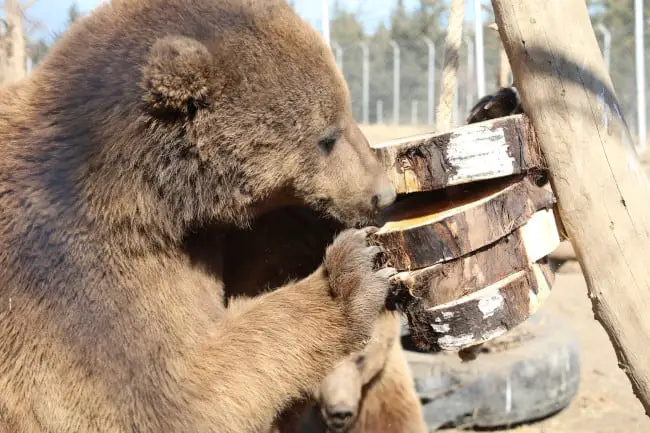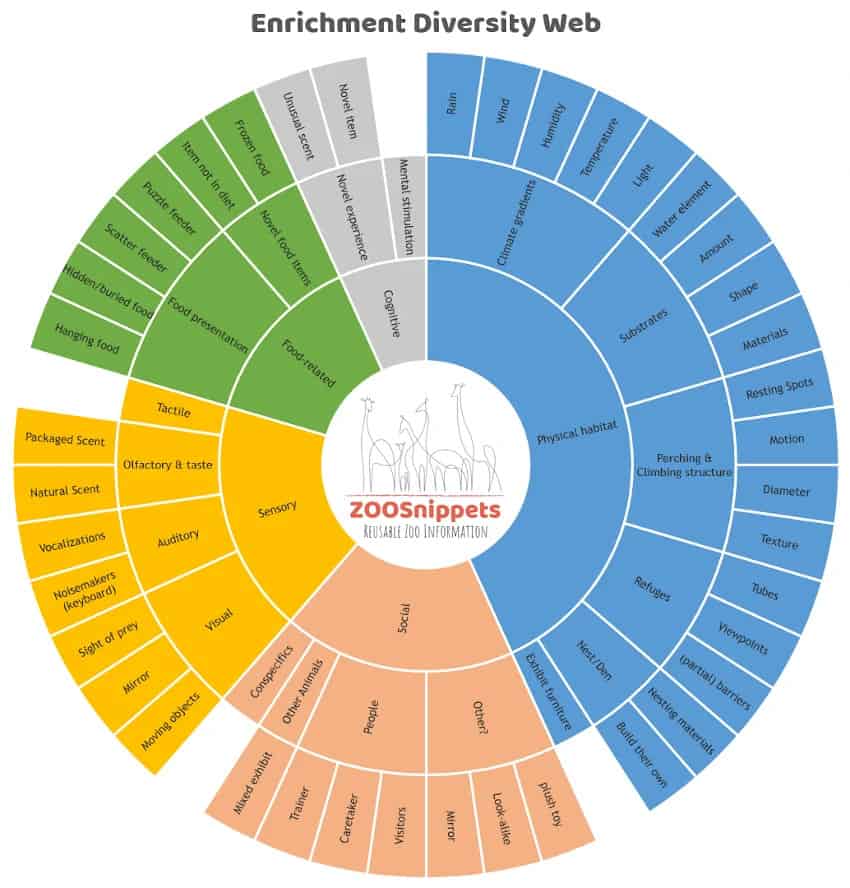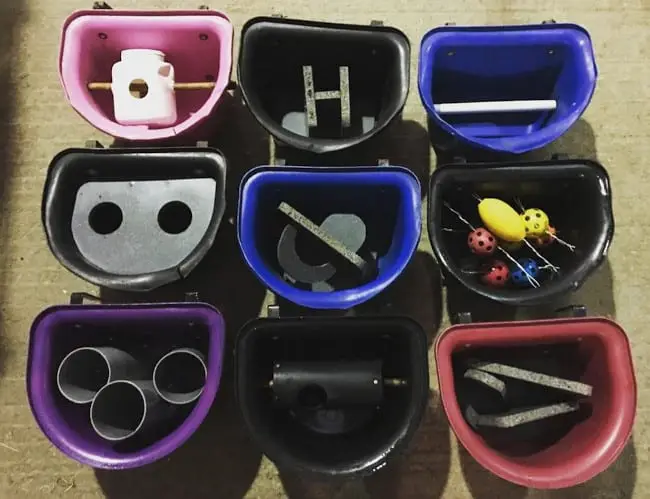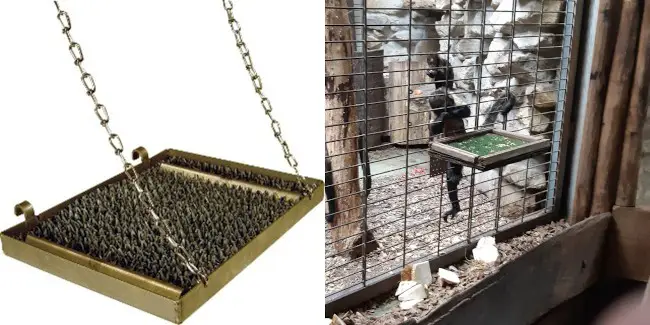When developing an enrichment program, one of the hardest tasks is creating the amount and variety of enrichment devices. To improve the behavioural welfare of the animal, you need to create a particular choice, change and complexity. In my zoo experience, I see many people struggling to think of new enrichment ideas and create new enrichment items. I often get the question to help someone with new enrichment ideas. And sometimes it can be difficult, especially when there is access to limited resources. However, because enrichment is given for many captive animals for a long time, there are many enrichment ideas already out there. And besides, the field of environmental enrichment is studied a lot, so there are many papers about the effectiveness of different types of enrichment. You only have to find them. And it would help if you are (at least a bit) creative. In this blog, I will talk about how I get new enrichment ideas and fit them in the behavioural goals I try to accomplish.
- Have a clear goal
- My approach for new enrichment ideas
- 1. Look at current enrichment collection
- 2. Searching for existing enrichment devices on social media
- 3. Searching for existing enrichment devices on websites, and in books and journals
- 4. Searching for existing enrichment devices available at vendors
- 5. Adjust the enrichment device for your need and goal
- 6. Prototype and testing
- Enrichment – It is all about creativity
- Wrapping up

Have a clear goal
Like I mentioned already, implementing enrichment is only useful if you have a clear purpose for it. Enrichment is just a tool within behavioural management you use to achieve something, in this case, a behaviour change. These goals can vary, and are not limited to, increase behavioural diversity, reduce abnormal behaviour, increase foraging behaviours and increase positive utilization of the environment. Your goal can also be a combination of the above. Whatever the case is, it is essential to have a clear goal to achieve. It is good practice, too, to have some criteria that describe the ultimate goal. For example, when you want to increase the foraging behaviour of a particular species, it is also worthwhile to think of what “increase” mean. Do you want to increase it by 100%, or even by 400%? Or is it that you want to lower the free available food? Maybe you want to increase the species-specific foraging behaviour like digging for food or searching for food. The more precise the goal is, the better you can find the right enrichment to achieve it. I can recommend reading the article about determining the need and priority of enrichment to help you set your goals. When you have set your enrichment goals, it is time for the fun part: search for enrichment ideas!
My approach for new enrichment ideas
We now know what we want to achieve, so we can think of how to achieve it. Here I will talk about my approach. However, there are more ways to find the right enrichment for your case. When searching for new enrichment ideas, be aware of the different types of enrichment and the diversity of enrichment possibilities.

1. Look at current enrichment collection
When I want something new to add to the enrichment collection, I first look at the current collection of enrichment devices available at the facility. Is there already something that can be used for my purpose, or maybe duplicate and make small alterations, so it fit my aim. One great way to implement change in the environment is making little variations of an existing enrichment device. A really great example of this principle is made by Rachel Puncher, Folly Farm Adventure Park & Zoo. She made many puzzle feeder variation of a standard food bowl for giraffes to stimulate tongue use, which is very important to decrease stereotype tongue behavioural commonly seen in giraffes. When used in rotation, you create a continuing challenge for them to collect their food.

2. Searching for existing enrichment devices on social media
Social media is an extensive library full of enrichment devices. Nowadays, just like ourself, people post and share many enrichment ideas on different social media platforms. It contains many valuable enrichment ideas which you can replicate, most of the time with photos and videos recording how animals use it. But, because social media can be overwhelming, it is good to know where you have to search. Let’s have a look at my most favourite social media platforms. When going through these platforms, I make a list of all possible enrichment ideas to reach my goals.
Pinterest is not the most used social media platform worldwide, but because it is based on sharing photos and videos, it is perfect as a library for enrichment ideas. When you have created a free account, you can start making your library and pin all the enrichment ideas you want to use or remember. And within all these arranged libraries of all users, you can search for ideas. Most often, I start my search very specific and work to a broader and broader search query. For example, I want to increase foraging time for otters which also stimulates natural foraging behaviours. I start my search query with something like “otter puzzle feeder enrichment” or “otter food enrichment in the water”. You can wider the search query by using “otter food enrichment” or “otter enrichment”. If you want to have a broad search, you can type something like “zoo enrichment” or “animal enrichment”. Every time you see a possible enrichment item, you pin it to your own library. Often when I find something interesting, I will look in the library of that user as well. Especially when he or she has a library board named something as zoo enrichment or animal enrichment. Also, have a look at our Pinterest environmental enrichment ideas board.
Youtube
With Youtube, you can easily find enrichment ideas. Youtube has not the most diverse enrichment items, but it is most beneficial that the enrichment ideas are presented with videos. You can immediately see how animals use enrichment items. But there is another reason Youtube is a good starting point for the search for new ideas. There are many build guides on how the enrichment is made, and that makes it easier to replicate and build the enrichment by yourself. One of the more popular Youtube channels is the one from Team Building With BITE. They make fantastic and diverse enrichment devices, and often a build guide is added. Another great company to follow is Big Cat Sanctuary. They upload enrichment videos on their channel regularly. Furthermore, when you type the species plus “enrichment” will give many great enrichment videos and is for me great inspiration in search of a new enrichment device. A quick tip: Always have a lookout for enrichment playlists! Sometimes when watching enrichment for other species will give the insight to alter it for the species you are looking enrichment for. And definitely have a look at our environmental enrichment ideas playlist.
One of the mainstream platforms is Facebook. Facebook is well known for its awesome enrichment groups. Next to many enrichment videos and photos, there is a whole community who can help you find ideas for your species. Relevant enrichment items and interesting community posts can easily be saved to remind yourself for later. I can only encourage you to join different enrichment groups and have a regular look on it for the latest enrichment items. Interesting and the more active groups to follow are The Shape of Enrichment, Animal Enrichment and Foraging and Zoo and Aquarium Animal Enrichment. But there are many more you can join.
The last social media platform that can be valuable is Instagram. The way I use Instagram is by following particular hashtags. This way, it shows many enrichment examples in your timeline. Hashtags that are interesting to follow are #zooenrichment, #environmentalenrichment, #animalenrichment and the more common #enrichment. You can try some other hashtags as well to see what it shows as a result. The benefit of Instagram is that it shows only photos and videos, and makes the enrichment ideas highly visual. The downside of Instagram is that it lacks a good search option to scroll quickly through all enrichment ideas for a particular species, and you can only search on hashtags, not keywords.
3. Searching for existing enrichment devices on websites, and in books and journals
There are some interesting websites to look at for enrichment inspiration. To name some that are worth a visit are the build guides from Team Building with BITE, Hose2Habitat, Wild Enrichment, and WildThink’s Enrichment Database. You should check them out, but unfortunately, they do not update the content regularly. There are some great enrichment books and special edition journals. I can highly recommend these books: ‘Second Nature: Environmental Enrichment for Captive Animals’, ‘Enriching Animals Lives’ and ‘Environmental Enrichment for Captive Animals’. Besides the valuable foundation of the enrichment theory, they discuss a lot of enrichment ideas that are done in other (mainly) zoos. Although, most of the times, photos are missing for the enrichment, so you can’t always replicate the enrichment devices easily. Another book that I can recommend too is ‘The Harpij Enrichment Book‘. This book is a bit older already, but it has still many helpful enrichment ideas for all types of enrichment categories and species.

4. Searching for existing enrichment devices available at vendors
Another approach that I often use is searching through the enrichment product range of commercial suppliers. Not to purchase the enrichment that I’m looking for, but to come up with enrichment ideas. There are many great enrichment devices at different vendors, but most often, they can be expensive. However, some enrichment items are easy to replicate and build by yourself, or you can use the principle of that enrichment and build your own enrichment device to achieve the same challenge. Vendors that you should definitely pay a visit are Bio-Serv, Aussie Dog, Otto Environmental, and Wildlife Toy Box.
5. Adjust the enrichment device for your need and goal
So you end up with a list of all kinds of enrichment ideas. But often you are not there yet. A lot of items are still not exactly fulfilling the need to achieve your specific goal. When I have such a list, I will take the top 5 most promising items and start thinking about how I can adjust them to fulfil my need. Maybe you need to scale the item, so it is more suitable for your animal. Take for example the video above. This enrichment item is perfect for big (carnivorous) animals to extend foraging time and cognitive challenge. But, when you scale it down to a smaller size, it is also suitable for animals such as small felids, otters or other mustelids. But sometimes it is not the size that needs to be adjusted but the material usage of the item. For example, you saw an excellent idea for enrichment, but it is made entirely out of wood. When you want to use it for rodents, it would be better to make it from steel. As another example, it could be that you saw a great puzzle feeder, but it would be still too simple for your animal. A possibility would be to add an extra layer of challenge to the item to make it more difficult. Let’s say; you have a puzzle feeder insect spinner which consists of a bamboo piece with holes. You can add an extra layer by building this bamboo tube within another tube with holes to make it more challenging to collect the food. Always try to think of if the ideas you obtained are already perfect for the job, or that they need some adjustment to make them fit better to achieve your goals.
6. Prototype and testing
You end up with a theoretical perfect enrichment device. Yes, theoretical. Because even if you saw videos and photos of the same species use the enrichment device does not mean your animals use the enrichment device in the same way. Maybe they are less interested, or it is too difficult or easy. With other words, it is important to make a prototype and test your enrichment device. Observe if the animals use it as is intended and evaluate your enrichment if it stimulates the behaviour you have aimed to encourage. Also, test it multiple times if the effect endures and also check the item’s durability. When you plan to use multiple devices in a group, it is sometimes better to start with one item to check if it works. In a nutshell; when you see that an item works on a photo or video does not prove that it works in your situation, especially when you adjusted the item by trying to make it more suitable for your circumstances. And if it does not work as you wish, you can always make some adjustment again.
Enrichment – It is all about creativity
When getting new enrichment ideas and designing new enrichment items needs a considerable amount of creativity. From experience, I can say that the best enrichment developed come forth out of creative thinking and team effort. You continuously need to look for solutions to reach your behavioural goals. It does not end by just replicating what others do or implementing the same enrichment as seen at other facilities. You repeatedly need to improve your enrichment items to make them better and more suitable for the goals you want to achieve.
Wrapping up
As is said by the beginning of this blog; this is the road I take when searching and developing new enrichment. This does not mean that you need to take the same path, but I hope that these steps and information will guide you to find the enrichment ideas and items that suit in your situation, your animals and your behavioural goals. And even when it sometimes looks complex and somewhat hard to find enrichment that fulfils your wish, by doing it more and more will make it easier with every new enrichment item you create.
Share this page!